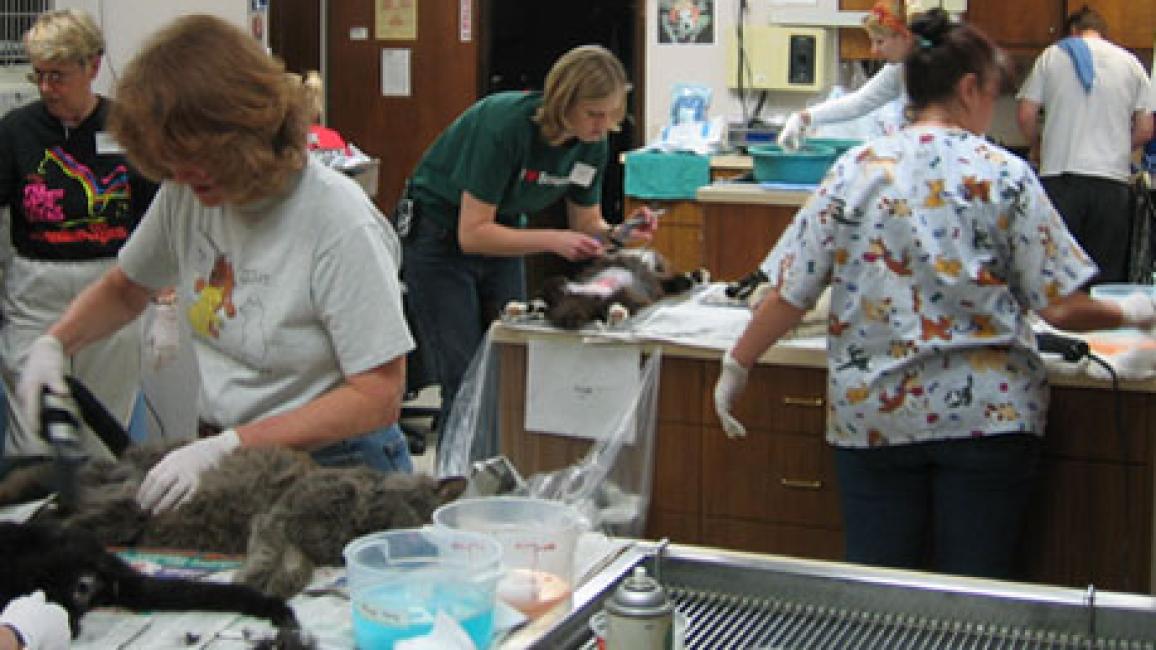Record-setting one-day high-volume spay neuter clinic in California

The morning skies may have been gloomy and threatening rain, but nothing could dampen the growing excitement at the Best Friends Catnippers high-volume clinic at VCA Arden Animal Hospital in Glendale, California, on Sunday, March 13. In the early hours, as volunteers checked in after walking past the rapidly growing number of trapped feral cats and caregivers lined up on the sidewalk outside the clinic's admitting area, almost every volunteer could be overheard saying, "How many kitties do we have so far?... Do you think we'll break our old record of 108 cats?"
New feral cat record
When the last scheduled caregiver, Joyce Pieper, arrived in her "Critter Coach" just before 10 o'clock with 12 trapped cats, all questions were answered. Best Friends Catnippers set a new high-volume spay/neuter clinic record, admitting 110 feral cats from 35 caregivers who traveled from as far away as Palmdale and Lancaster.
"With the spring mating season upon us, the timing of this record-breaking clinic couldn't be more perfect," stated Karn Myers, Co-Founder of Best Friends Catnippers and Clinic Supervisor. "We were also fortunate to have dry weather Saturday evening. Los Angeles has had so much rain in the last few months. Many of our caregivers have experienced challenges and delays in Trap-Neuter-Returning (or TNRing) the cats in their colonies. We're so glad that Mother Nature cooperated with us," continued Karn.
At check-in, the admitting team carefully assessed and logged-in each cat with caregivers providing any known medical concerns. "It's imperative that our caregivers alert us to any medical problems troubling the cat," stated Dr. Lisa Pierson, DVM. "These clinics provide both a spay/neuter opportunity and the chance to improve these cats' health. Our goal is to improve the quality of their life and the life of their colony-mates," continued Dr. Pierson.
Spay and neuter surgery prep and procedure
After being anesthetized in their traps by a team of expert technicians, each cat is removed from its trap and begins its journey through the spay/neuter clinic. First, each cat is prepared for surgery, then sent on to be spayed or neutered. After their surgery, each cat visits the many stations set up in and around the VCA Arden Animal Hospital and staffed by expert technicians and lay volunteers. The cats' first stop is the intensive care and medications station where technicians administer fluids, antibiotics, vaccinations (Rabies & FVRCP) and Droncit for de-worming. The teeth cleaning station, where dental technicians clean and extract any problem teeth, is the next stop for the ferals. After the dental station, the cats visit the eartipping station where a technician removes each cat's right ear tip. This process, called eartipping, is done for field identification purposes.
Eartipping the felines
After being eartipped, the cats receive a mini-spa treatment in the grooming tent where volunteers administer Revolution and brush them, removing tangled fur and fleas. As the cats are making their way through the various stations, their traps are cleaned, sanitized and lined with fresh newspaper. Both traps and cats are matched up again in the recovery tent where the cats are monitored continuously as they awaken from their surgeries and wait for their caregivers to pick them up.
Volunteers help with cats
The 60+ volunteers who donate their time and expertise at the Catnipper clinics relish the opportunity to care for these often-forgotten feral cats. They cradle the sleeping ferals, cooing sweet expressions to the cats as they gingerly pass them from person to person.
"I really feel as though I'm making a difference in the lives of these kitties," stated clinic volunteer Nadia Sutton. "While these feral kitties are anesthetized, this is a once-in-a-lifetime opportunity to hold them. These kitties never get to feel the loving touch of a person's hand stroking their tail or rubbing their ears. I hope the love we all feel towards these kitties is transferred to them somehow– perhaps in happy dreams as they sleep their way through the clinic day."
Find out more about trap-neuter-return (TNR).